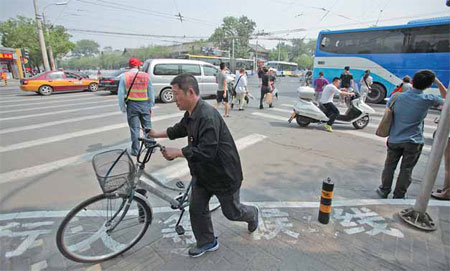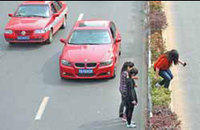Jaywalkers tread with care in capital
Updated: 2013-05-09 08:07
By He Na, Zhang Yuchen and Peng Yining (China Daily)
|
||||||||
|
A crossroad in Beijing's Di'anmen area. A new regulation came into force on Monday allowing police to fine people who cross the road recklessly, either on foot or by bike, in an attempt to improve traffic safety in the city. Wang Jing / China Daily |
|
Traffic police in many parts of the country have launched a campaign to strengthen punishments for jaywalkers. You You / for China Daily |
Offenses expected to decline with introduction of fines, report He Na, Zhang Yuchen and Peng Yining in Beijing.
A red light and crowd of pedestrians rushing across the street: It's a common sight in Beijing. However, the frequency of jaywalking is expected to decline following a new regulation that allows police to fine those who cross the road recklessly, either on foot or by bike.
The new rule, which came into force on Monday, means jaywalking comes at a price - 10 yuan ($1.60) for pedestrians and 20 yuan for cyclists. Twenty thousand people were fined during a monthlong trial to assess the feasibility of the ruling.
"To further regulate jaywalkers, the traffic police have improved the infrastructure at 150 major intersections in the capital, and extra staff are being deployed there during rush hours. Many jaywalkers have been fined on the spot," said Jiang Jing, a spokeswoman for Beijing Traffic Management Bureau.
To ensure that pedestrians have enough time to cross the road safely, the bureau has conducted a review of traffic lights at the specified intersections to optimize the timing and duration of red and green lights.
"We adjusted and extended the duration of green lights at some junctions that experience a large numbers of pedestrians, such as those near hospitals and schools," said Jiang. "And at certain junctions where the heavy traffic flow often prevents pedestrians from crossing, we've already formulated plans to optimize the traffic flow and will deploy extra staff to help if necessary."
To further emphasize the authority of the traffic police and traffic wardens, the bureau has equipped wardens with flags and bullhorns so they can direct pedestrians and cyclists and remind them of the rules.
"Before the fine on pedestrians and cyclists was introduced on May 6, we had already been emphasizing the rules at my intersection for a month. Banners with slogans on them were set up at the intersection to remind people at the crosswalk to obey the lights, and also to educate those who ignore the lights," said Hu Yali, 55, a traffic officer at the Nanluoguxiang crossroad in Beijing.
"The promotion had some impact. The number of people who ignore the lights is much lower than before," said Hu, who voiced her support for the new system.
"I have to say that the effect of fining pedestrians and cyclists who ignore red lights has been instant. Only few people have been fined and most pedestrians and cyclists behave well," she said.
"If I were a jaywalker, I would think twice before crossing against the lights: 10 yuan is the cost of dinner for some people, especially those on low incomes - at least it's enough to buy vegetables for dinner. Anyway, I hope this tough measure will help to foster good habits," she added.
Zhao Jie, director of the Urban Transport Institute at the China Academy of Urban Planning & Design, said the authorities had to establish the new system to prompt pedestrians to abide by the traffic rules, but he felt the authorities should also examine the placement of lights, street signs and crosswalks in the capital.
"The city should offer help for pedestrians to cross the road," he said. "At present, the reality is that we don't have enough crosswalks, and they usually have limited room for pedestrians to stand while waiting to cross. There is far less consideration for pedestrians than vehicles," he said.
When faced with heavy traffic congestion, the government simply builds more highways, but seldom thinks of building more crosswalks, he added.
The crossroads at many intersections have been widened twofold to accommodate traffic. But the time between the green and red lights is far too short and even young people need to run to cross the road in time. Because vehicles are not prohibited from turning right at the intersection, pedestrians are forced to wait in the middle of the traffic. So the 40 or 50 seconds allocated for crossing the road are really just theoretical and the actual crossing time is far shorter.
People should regard traffic lights as a physical embodiment of the laws of the road and the government has a responsibility to raise awareness of those laws, according to Zhao.
"It was necessary to enforce the penalties to inculcate good habits on the roads. But the government should also realize that the needs of pedestrians should be one of the top priorities when roads are planned. Penalties alone won't offer a lasting solution to the situation. "
Contact the writer at hena@chinadaily.com.cn
(China Daily 05/09/2013 page6)

 Michelle lays roses at site along Berlin Wall
Michelle lays roses at site along Berlin Wall
 Historic space lecture in Tiangong-1 commences
Historic space lecture in Tiangong-1 commences
 'Sopranos' Star James Gandolfini dead at 51
'Sopranos' Star James Gandolfini dead at 51
 UN: Number of refugees hits 18-year high
UN: Number of refugees hits 18-year high
 Slide: Jet exercises from aircraft carrier
Slide: Jet exercises from aircraft carrier
 Talks establish fishery hotline
Talks establish fishery hotline
 Foreign buyers eye Chinese drones
Foreign buyers eye Chinese drones
 UN chief hails China's peacekeepers
UN chief hails China's peacekeepers
Most Viewed
Editor's Picks

|

|

|

|

|

|
Today's Top News
Shenzhou X astronaut gives lecture today
US told to reassess duties on Chinese paper
Chinese seek greater share of satellite market
Russia rejects Obama's nuke cut proposal
US immigration bill sees Senate breakthrough
Brazilian cities revoke fare hikes
Moody's warns on China's local govt debt
Air quality in major cities drops in May
US Weekly

|

|









